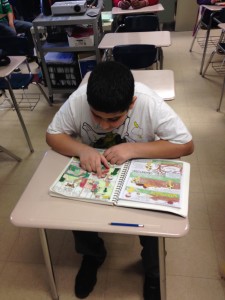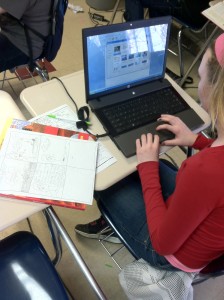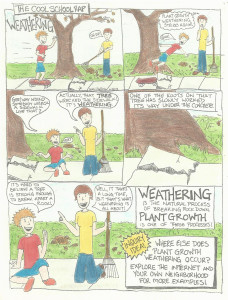
Student learning science with Balliett’s comic
by Heather Soulen
Middle school can be a tough and unforgiving rite of passage, filled with raging hormones, ill-fitting highwater pants, voices akin to trumpet-wielding geese, and a multitude of distractions. Trying to learn while being swept up in puberty’s turbulence can be challenging. Equally challenging is trying to teach science to often-distracted tweens and teens. Right now, as most U.S. schools begin a new school year, some science educators might be looking for ways to engage their middle-school students with science. One science educator suggests meeting them where their interests lie – comics.
Ohio-based middle school science educator Laura Balliett is doing just that with her comic series Cool School Rap. She described her novel approach at the Smithsonian Environmental Research Center earlier this year when invited to speak at PaxCon2016, a conference exploring environmental education and science communication along Maryland’s Patuxent River. An avid writer and artist, Balliett made a New Year’s resolution in 2013 – to start using her writing and art to help her middle-school students learn science concepts more effectively. She started doodling, creating characters and storylines, and just before standardized testing that year, she created two comics for her students to use as study guides. Then something amazing happened.
“The moment I handed my first comic over to my students, there was excitement,” she said. “I got a lot of ‘COOL’ and ‘You drew this?’”
Balliett discovered comics simply weren’t as intimidating as lines upon lines of text. She found that many students struggle when confronted with lengthy text, and this struggle intensifies for those she calls ‘reluctant readers.’ “[They] lack confidence in their reading abilities and would frequently snub off reading textbooks, articles and even instructions. With a comic, information is delivered fast.”
Later, Balliett started including comic development prompts for students. She’d share one of her comics explaining a broad science topic, like weathering and she’d then ask students to research aspects of this topic and use their findings to create their own comics. “I actually call my class STEAM because I incorporate art.” When it comes to learning, she said, “being able to visually represent design ideas and [show] comprehension of concepts is also a very important aspect.”
Today, science education is experiencing a monumental shift. Out went the ‘lather, rinse, repeat’ method of memorizing facts, and in came a fresh, and much-needed initiative called the Next Generation of Science Standards (NGSS). This three-dimensional approach is designed to have students model the way scientists work and think, deepening their understanding of scientific ideas and engaging in practices that scientists actually use, like asking questions, solving problems and working collaboratively. By modeling scientists, students are meant to discover how science, technology, engineering and mathematics (the four STEM fields) are relevant to their everyday lives.
Naturally, there were students who hesitated, claiming they couldn’t draw. “I know they’re frustrated, and I try to tell them that it’s really all practice and that everybody can draw if you practice,” she said. She understands their frustrations all too well: She had a love-hate relationship with drawing hands. Taking her own advice, she began to intensely draw hands, starting at staff meetings.
“I’d look at the other colleagues…at their hands and I’d doodle in my notebook,” she recalled with a laugh, acknowledging that she should have been taking notes. “Practice is my number one thing. Everyone says they can’t do something, but if you practice and practice, it really works.”

Student researching and creating their own science-related comic
Balliett is patient with students who feel they lack the talent for drawing, often sitting with them and looking at pictures. Together they gradually dissect a picture, analyzing for shapes and the spatial relationships between the shapes. “A lot of kids feel like they can’t draw. It’s very important that kids can see what they’re drawing.” By taking time to work with them, giving them encouragement, they begin to feel empowered to explore a new medium.
Recent research demonstrates that engaging with multiple types of content, as with comics (text and images), supports deeper cognitive learning because individuals must actively process and integrate varied types of information1. The time Balliett spends with students critically analyzing and dissecting images encourages critical thinking skills and cognitive learning. Research has shown that this kind of exercise can transfer problem solving to other fields, such as science and mathematics1, 2. Today, neuroscientists are studying the creative process, asking how it’s manifested in the brain and in the art that connects STEM and other forms of disciplinary knowledge3.
What’s Balliett’s favorite part about using comics in an educational setting? “When I see people actually reading it and learning from it.” She said she gets comments on the Cool School Rap Facebook page like, “Oh my gosh – I never knew this!” and “I just learned something!” It’s moments like this, she said, when she feels like, “I’m actually doing my job. This was definitely what I was born to do. I’ve been drawing all my life and now I’ve finally figured out my channel. I’m not going to stop doing it – I don’t see it going away.”
Laura Balliett is a middle school science educator at Harding Middle School in Lakewood, OH. In addition to Cool School Rap, she also has a series of environmental and sustainability comics called Eye Opening Comics aimed at providing tips and solutions to some of our biggest problems facing the planet. Check out these comics on her website.
While Ohio has not formally adopted NGSS into their educational programming, they have reviewed the document to identify resources and strategies to support Ohio’s Learning Standards in Science created in 2011.
Laura’s Links:
Cool School Rap website
Cool School Rap on Facebook
Cool School Rap on Pinterest
Cool School Rap on Twitter
Cool School Rap video
Eye Opening Comics website
Recent Research on Neuroscience, Cognition, Critical Thinking and the Arts:
- Jennifer Groff (2013) Expanding Our “Frames” of Mind for Education and the Arts. Harvard Educational Review: April 2013, Vol. 83, No. 1, pp. 15-39. http://dx.doi.org/10.17763/haer.83.1.kk34802147665819
- Tyler CW and Likova LT (2012) The role of the visual arts in enhancing the learning process. Front. Hum. Neurosci. 6:8. doi: 10.3389/fnhum.2012.00008
- Siler T (2015) Neuroart: picturing the neuroscience of intentional actions in art and science. Front. Hum. Neurosci. 9:410. doi: 10.3389/fnhum.2015.00410


